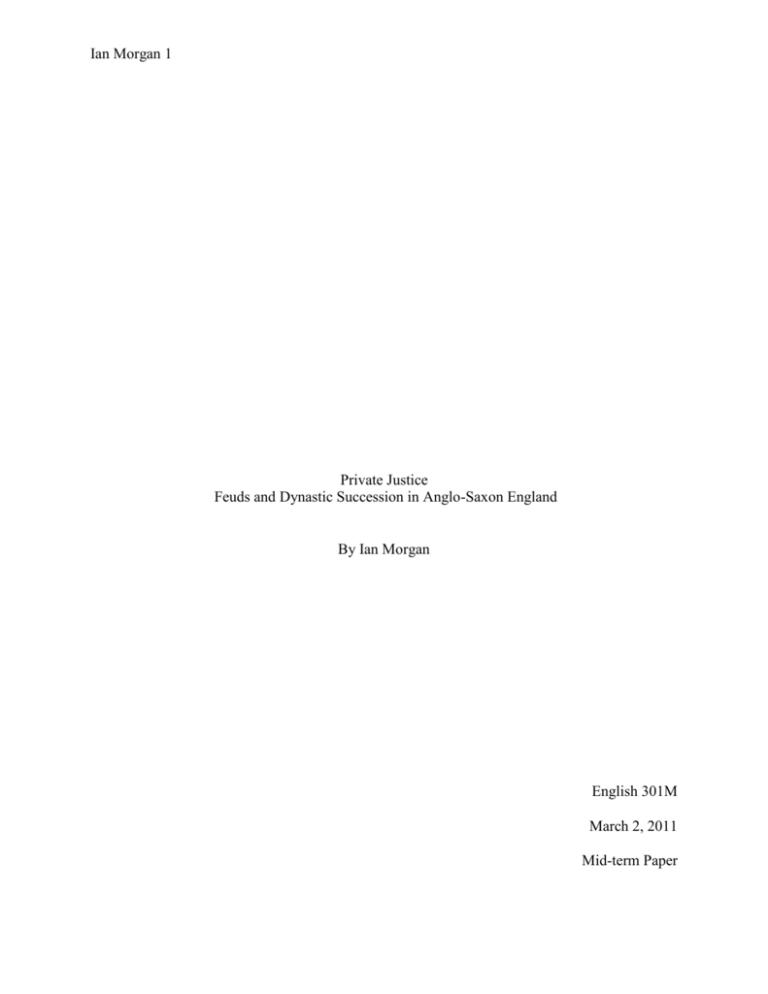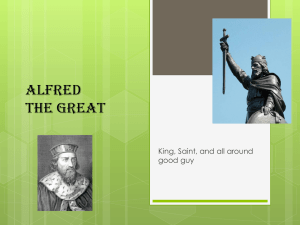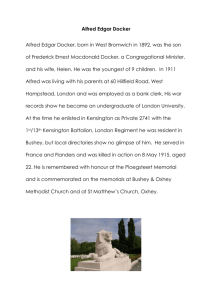Conflict resolution in Anglo
advertisement

Ian Morgan 1 Private Justice Feuds and Dynastic Succession in Anglo-Saxon England By Ian Morgan English 301M March 2, 2011 Mid-term Paper Ian Morgan 2 Conflict resolution in Anglo-Saxon society was often a bloody affair. Operating through virtually all levels of the social strata, a system of feuding dictated how retribution for personal injustices could be attained. While feuds in general were commonplace, disputes between kings were frequently recorded in writing. In a time of perpetual warring with invading Viking armies, orderly dynastic succession was of the utmost importance. Though few manuscripts from the period remain intact, the avoidance and control of feuds is a major theme throughout the available literature; however, the treatment of this subject varies. The typically objective AngloSaxon Chronicle presents the dynastic feud between Cynewulf and Cyneheard in the 757 entry as a cautionary tale warning of the dangers and scope of feuds at the highest levels of society. Asser’s Life of King Alfred similarly discusses the risk of dynastic feuding; particularly the case of the succession of King Aethelwulf’s throne, from the polemical perspective of King Alfred’s court. Finally, the laws and will of King Alfred reflect a ruler concerned with limiting the inherent danger of dynastic feuds. The Blackwell Encyclopedia of Anglo-Saxon England describes a feud as “conditions of hostility between individuals or groups within the community caused by wrongs done by one side to the other. The consequences of this hostility could be acts of private revenge or settlement” (Lapidge et al. 182). Indeed, feuds were dangerously cyclical by nature due to the extensive kinship and lordship ties of the age. As Blackwell states, “private justice played an important role in the resolution of disputes” and once a feud was initiated, it often took third party mediation to resolve the matter (182). This notion of duty stems in part from the AngloSaxon lordship principle. A man was obliged by law to “keep carefully his oath and his pledge,” as King Alfred succinct opening to his Laws states (Keynes and Lapidge 164). This place of precedence within the law code is evidence of the importance assigned to honoring one’s oath. Ian Morgan 3 With an entire section titled “Concerning the feud,” King Alfred’s laws provide insight as to the prevalence of feuds in Anglo-Saxon society (Keynes and Lapidge 168). The laws indicate intricate, developed rules of engagement that feuding parties must observe. Specific laws ranging from “a man who knows his enemy to be dwelling at home is not to fight before he asks justice for himself” to the protocol one must follow when his “enemy reaches a church” imply a tradition of feuding that was deep-seeded in the culture (Keynes and Lapidge 169). As a ruler facing near continuous Viking onslaughts, Alfred was inclined to curb the self-defeating tradition. In this vein, we see laws that provide exceptions to the normative feud provocations. For example, a man was allowed to fight “without incurring a feud” if he discovers any man unlawfully violating a female relative (Keynes and Lapidge 169). Likewise, stipulations exist that allow a thegn to fight for his lord or a “man on behalf of his born kinsman” without incurring a feud in the process (169). While laws such as this ensured that feuds did not expand exponentially, they also provide an idea of how extensive these disputes could be. Among the most famous feuds recorded appears in the 757 entry of the Anglo-Saxon Chronicle. The entry records the deposition and murder of the West Saxon King Sigeberht and the subsequent, 30-year feud that followed between his usurper Cynewulf and his brother Cyneheard. The entry is stylistically unique for several reasons. First, it is notably longer than most Chronicle entries. Typically a few brief lines, the average entry is concise and relatively basic. However, the 757 entry is oddly stylized with an unusual attention to detail. The chronicler notes that Cynewulf was “visiting his mistress” when he was attacked by Cyneheard. Furthermore, the chronicler comments that Sigeberht was killed after a “swineherd stabbed him to death by the stream at Privet” (Crossley-Holland 37). Such attention to detail is peculiar for the Anglo-Saxon Chronicle. Also, while the Chronicle is typically a predominantly objective Ian Morgan 4 source, the 757 entry is ambiguously moralizing. When asked if they would accept “money and land” in exchange for their loyalty, the thegn’s of the slain King Cynewulf reply that “no kinsmen was dearer to them then their lord and they would never serve his slayer” (CrossleyHolland 38). Scholars have debated what this addition to the tale means. Often the 757 entry is cited as evidence that lordship ties “had proved stronger than the ties of kinship when the two came into conflict with each other” (Blair 252). This explanation for the bizarre inclusion of the words of the thegns is widely accepted as it fits nicely with the idea that lordship bonds during this period had developed beyond the archaic kinship bonds of Germanic peoples. Stephen D. White, however, disputes the claim that the entry is evidence that kinship ties were a “negligible force” in Anglo-Saxon society (10). In fact, White’s article broadly reanalyzes the conventional interpretations of the entry, reframing the story as an “intrafamilial royal feud” (10). Although White implies that his thesis is naturally as speculative as any other, he sheds light on the ambiguity that surrounds the entry. The entry seems not to be a story about the honor of warriors, but rather a cautionary tale about the dangers of unhindered feuding. For what was implicitly the senseless killing of Sigeberht in 757, a king, a powerful lord and a large portion of their thegns were killed. The entry acknowledges the fatalistic attitudes of the men, who “continued to fight until they all lay dead” (Crossley-Holland 38). The feud between Cyneheard and Cynewulf highlights the wide range of devastation that this tradition could incur. Perhaps it was vivid tales such as this that provoked later kings to do their best to avoid deadly feuds. Such is the case of King Aethelwulf in dealing with his rebellious son King Aethelbald. Presented both in the Anglo-Saxon Chronicle as well as in Asser’s Life of King Alfred, the ascension of Aethelbald shows the danger a feud could pose to a royal family. Ian Morgan 5 Interestingly, however, both texts treat the incident differently. While Asser devotes four chapters from the Life of King Alfred to a description of Aethelbald’s treachery and wrongdoing, the Anglo-Saxon Chronicle glosses over the revolt, noting simply that “Aethelwulf’s two sons succeeded to the kingdom” (English Historical Documents 190). The Chronicle disregards any sense of plotting on the part of Aethelbald, perhaps, “because the chronicler was embarrassed by the event for personal reasons or because he wished to brush over this expression of recent discord within the royal family” (Keynes and Lapidge 234). However, Asser’s eagerness to elaborate on the issue suggests that at least King Alfred was displeased by the coup. Asser assumes a decidedly anti-Aethelbald tone throughout the chapters in which he discusses his ascension and reign. Using invective to make his point, Asser refers to the incident as a “disgraceful episode” and to Aethelbald as an “iniquitous and grasping son” (Keynes and Lapidge 70). While these may be Asser’s reflections, it is more likely that King Alfred’s views are shining through his bishop. Asser frequently notes that Aethelwulf “loved [Alfred] more than his other sons,” an assertion that seems to be supported by Aethelwulf’s actions before his death (Keynes and Lapidge 70). Considered a “religious and unambitious man,” Aethelwulf had a reputation for excessive piety (Stenton 245). Shortly before his death in 858, and in the midst of continuing Viking attacks, Aethulwulf, with Alfred, made a drawn out journey to Rome, stopping in France on the return trip. The pilgrimage was momentous; Aethulwulf married Judith, the daughter of Charles the Bald, and soon after received word that Aethelbald had made his claim to the English throne. Witnessing these events and undoubtedly absorbing the opinions of those around him was the seven-year-old Alfred. From this perspective, Alfred’s (and as a matter of consequence, Asser’s) polemic is explained. More importantly, Alfred’s thirty year grudge is evidence as to the lasting nature of feuds. Ian Morgan 6 Aethelbald’s dissension against his father set the stage for what could have been a divisive and magnanimous feud. Asser states that King Aethelbald was backed by “Eahlstan, bishop of Sherborne along with Eanwulf, ealdorman of Somerset” while Aethelwulf maintained the support of most nobles in the country (Keynes and Lapidge 70). Just as in the feud between Cynewulf and Cyneheard, Aethelwulf and Aethelbald were each supported by a following of devoted, powerful men. Although it is noted that “feuds arose typically… as a consequence of homicide,” Aethelbald’s attempt at the crown seems belligerent enough to incite combat (Lapidge et al. 182). However, to avoid “civil strife … with father and son at war,” Aethelwulf appeased Aethelbald by making diplomatic moves to correspond to the military concessions (Keynes and Lapidge 70). Splitting the kingdom, while simultaneously maintaining the right to bequeath it, Aethelwulf compromised. Furthermore, Aethelwulf’s marriage to Judith seems to have been an effort to undermine his son’s pursuits by, as Michael Enright puts it, “[demonstrating] to the Wessex rebels that he had foreign support and that they might expect the antagonism of the Frankish king” (293). This hypothesis is supported by Aethelwulf’s odd decision to allow Judith to “sit beside him on the royal throne until the end of his life” (Keynes and Lapidge 71). Actions like this suggest that Aethelwulf was taking measures to peacefully resolve the power struggle; the potential fallout from the feud between Aethelwulf and Aethelbald could have ruined the beleaguered English kingdom. Alfred’s early experience with the tribulations of dynastic succession shaped his actions as he neared the end of his own reign. The Will of King Alfred reveals a thoughtful consideration of the challenges of royal succession. Firstly, Alfred points to the will of his father, systematically listing the history and development of the document. By calling on this authoritative manuscript, Alfred does his best to legitimize his current and dynastic claim to the Ian Morgan 7 kingship. He notes at the end of the will that any loose ends should be resolved by “[observing] the directions that stand in my father’s will,” implying that he is only carrying out Aethelwulf’s wishes (Keynes and Lapidge 178, Wormald 270). Nevertheless, Alfred notes the conversations he conducted with King Aethelred regarding the inheritance of their sons and the effect that these conversations made on the will. Edward is clearly positioned to be the primary beneficiary of the kingdom. Yet for all its political maneuvering, Alfred’s will may not have been an unchallengeable legal document. His nephew Aethelwold, who would eventually revolt against the newly crowned King Edward, had a valid claim to the kingship when the will was drawn around the mid-980’s. Just as, due to his mature age, Alfred accepted the kingship over the young Aethelwold upon the death of Aethelred, so could Aethelwold have assumed to bypass Edward as the rightful king. Barbara Yorke notes that the “rules of succession were not fixed at this time, and primogeniture was certainly not established” (Yorke 30). Furthermore, Aethelwold would have had several other reasons for believing that he was the legitimate heir apparent. Yorke states that while Edward was the son of King Alfred, Aethelwold was the son of a consecrated queen (31). Just as Aethelwulf thought that the consecration of Judith would strengthen his kingship, so did Aethelred. Also, an undated charter witnessed by both Edward and Aethelwold places Aethelwold above Edward as the “filius regis, or the son of a king” (Yorke 31). Though such a document may be negligible, it implies that there was not a concrete recognition of Edward as the heir apparent. After watching the tense ascension of Aethelbald to the kingship, Alfred was surely aware of the dangers that existed due to Aethelwold’s claim. Thus, Alfred’s will is definite in its intent to pass the kingdom to this first born son. Alfred bequeaths the majority of the land Ian Morgan 8 holdings in the kingdom to Edward; moreover, the estates promised to Edward form a defensive perimeter around the land and constitute necessary strategic strongholds for a king (Keynes and Lapidge 173). Alfred respects the agreement with King Aethelred that he cites at the beginning of the will and does not completely neglect his nephew. However, the land bequeathed to Aethelwold was scant and comprised of East-Saxon land holdings: Asser notes that the West Saxon region “has always been more important than the eastern” (Keynes and Lapidge 70). Beyond the drafting of the will, Alfred made other, more discreet efforts to bolster Edward’s position of inheritance. By the 990’s, Edward was playing a more prominent role in the military alongside his father, leading a group against the Vikings in 892 (Yorke 32). Yorke also identifies the “witan” that would have backed Edward’s ascension to the kingship. From powerful uncles and other kinsmen to ecclesiastical figures such as Asser, Alfred ensured that Edward would be surrounded and supported by men “committed to [his] succession” (Yorke 34). Yet despite the great lengths to which Alfred went to ensure that a peaceful transfer of power took place, Edward was faced with immediate revolt upon his father’s death. Aethelwold’s rebellion began when he “seized the residences as Tyneham and Wimborne” (Crossley-Holland 120). Here Alfred’s laws “concerning the feud” play a role in the treatment of Aethelwold. Barricaded in the estate, dramatically stating that he will either “live there or die there,” and surrounded by Edward’s forces, Aethelwold embodies the dynastic feud that was so damaging in Anglo-Saxon times. Though he “stole himself away during the night,” escaping the immediate conflict with Edward, Aethelwold fled to North Umbria and the Vikings where they “received him as their king and submitted to him” (Crossley-Holland 120). James Campbell notes that the “striking thing … is that for a few years Aethelwold had extensive success” (21). Assuming control of the Northumbrians, Aethelwold then made notable alliances with the East Ian Morgan 9 Angles and Essex that reflect a man of considerable power. Thus one can appreciate the concern Alfred had in considering the succession of his son while Aethelwold survived. Ultimately the two armies met at a battle in the Danelaw and, as Campbell puts it, “the casualty list… is enthralling” (21). Among the dead were King Eohric of the East Angles, multiple ealdormen, multiple “men of distinction,” and Aethelwold himself, thus putting an end to the rebellion (Campbell 21). Nevertheless, the dynastic feud that Alfred tried so carefully to avoid eventually caused a large scale battle that shaped 10th century politics and claimed the lives of many important men. The issue of dynastic succession and the difficulties it poses for a kingdom is a recurring theme throughout Anglo-Saxon literature and history. As the 757 entry and Asser’s account of Aethelbald’s treachery show, feuds and grudges could be maintained for decades or longer. Oftentimes these feuds between the rich and powerful were a catalyst for sweeping historical events, as seen in Aethelwold’s final battle. The literature reflects this, as men like King Alfred and King Aethelwulf took bureaucratic and diplomatic strides to avoid dynastic strife within their own families. Ian Morgan 10 Works Cited Blair, Peter Hunter. Roman Britain and early England, 55 B.C.-A.D. 871. New York: Norton Library, 1963. 252. Print. Campbell, James. “What is not known about the reign of Edward the Elder.” Edward the Elder: 899-924. Eds. N.J. Higham and D.H. Hill. London: Routledge, 2001. 12-24. Print. Crossley-Holland, Kevin, ed. The Anglo-Saxon World: An Anthology. New York: Oxford University Press, 1982. Print. English Historical Documents. Ed. by Dorothy Whitelock. Vol. 1. Routledge, 1979. Print. Enright, Michael J. “Charles the Bald and Aethelwulf of Wessex: the alliance of 856 and strategies of royal succession.” Journal of Medieval History 5.4 (1979): 291-302. Print. Keynes, Simon and Michael Lapidge, eds. Alfred the Great: Asser’s Life of King Alfred and Other Cotemporary Sources. London: Penguin, 1983. Print. Lapidge, Michael, et al, eds. Blackwell Encyclopedia of Anglo-Saxon England. Oxford: Blackwell Publishers, 1999. Print. Stenton, Frank. Anglo-Saxon England. 3rd ed. Oxford: Oxford University Press, 1989. 245-246. Print. White, Stephen D. “Kinship and Lordship in Early Medieval England: the Story of Cyenwulf and Cyneheard.” Viator 20 (2008): 1-18. Print. Wormald, Patrick. “Onpa wapnedhealfe: Kingship and royal property from Aethelwulf to Edward.” Edward the Elder: 899-924. Eds. N.J. Higham and D.H. Hill. London: Routledge, 2001. 264-279. Print. Yorke, Barbara. “Edward the Aethling.” Edward the Elder: 899-924. Eds. N.J. Higham and D.H. Hill. London: Routledge, 2001. 25-39. Print.








![February [Aaron, Teig, Tessa]](http://s2.studylib.net/store/data/005219060_1-ad628f0d0374681b1bbde0538b54e11c-300x300.png)